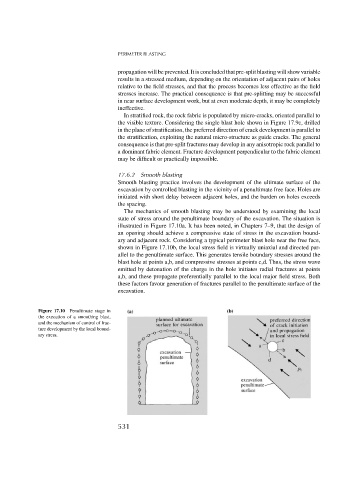Page 549 - Rock Mechanics For Underground Mining
P. 549
PERIMETER BLASTING
propagation will be prevented. It is concluded that pre-split blasting will show variable
results in a stressed medium, depending on the orientation of adjacent pairs of holes
relative to the field stresses, and that the process becomes less effective as the field
stresses increase. The practical consequence is that pre-splitting may be successful
in near surface development work, but at even moderate depth, it may be completely
ineffective.
In stratified rock, the rock fabric is populated by micro-cracks, oriented parallel to
the visible texture. Considering the single blast hole shown in Figure 17.9c, drilled
in the plane of stratification, the preferred direction of crack development is parallel to
the stratification, exploiting the natural micro-structure as guide cracks. The general
consequence is that pre-split fractures may develop in any anisotropic rock parallel to
a dominant fabric element. Fracture development perpendicular to the fabric element
may be difficult or practically impossible.
17.6.2 Smooth blasting
Smooth blasting practice involves the development of the ultimate surface of the
excavation by controlled blasting in the vicinity of a penultimate free face. Holes are
initiated with short delay between adjacent holes, and the burden on holes exceeds
the spacing.
The mechanics of smooth blasting may be understood by examining the local
state of stress around the penultimate boundary of the excavation. The situation is
illustrated in Figure 17.10a. It has been noted, in Chapters 7–9, that the design of
an opening should achieve a compressive state of stress in the excavation bound-
ary and adjacent rock. Considering a typical perimeter blast hole near the free face,
shown in Figure 17.10b, the local stress field is virtually uniaxial and directed par-
allel to the penultimate surface. This generates tensile boundary stresses around the
blast hole at points a,b, and compressive stresses at points c,d. Thus, the stress wave
emitted by detonation of the charge in the hole initiates radial fractures at points
a,b, and these propagate preferentially parallel to the local major field stress. Both
these factors favour generation of fractures parallel to the penultimate surface of the
excavation.
Figure 17.10 Penultimate stage in
the execution of a smoothing blast,
and the mechanism of control of frac-
ture development by the local bound-
ary stress.
531

